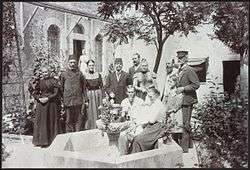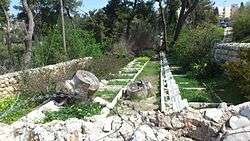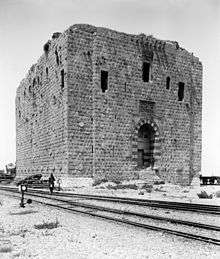American Colony, Jerusalem


The American Colony was a colony established in Jerusalem in 1881 by members of a Christian utopian society led by Anna and Horatio Spafford. Now a hotel in East Jerusalem, it is still known by that name today.
History
After suffering a series tragic losses following the Great Chicago Fire of 1871 (see "It is Well with My Soul"), Chicago residents Anna and Horatio Spafford led a small American contingent in 1881 to Jerusalem to form a Christian utopian society. The "American Colony," as it became known, was later joined by Swedish Christians. The society engaged in philanthropic work amongst the people of Jerusalem regardless of religious affiliation, gaining the trust of the local Muslim, Jewish, and Christian communities.[1] During and immediately after World War I, the American Colony carried out philanthropic work to alleviate the suffering of the local inhabitants, opening soup kitchens, hospitals, orphanages and other charitable ventures.
Although the American Colony ceased to exist as a religious community in the late 1940s, individual members continued to be active in the daily life of Jerusalem. Towards the end of the 1950s, the society's communal residence was converted into the American Colony Hotel. The hotel is an integral part of the Jerusalem landscape where members of all communities in Jerusalem still meet. In 1992 representatives from the Palestine Liberation Organization and Israel met in the hotel where they began talks that led to the historic 1993 Oslo Peace Accord.
The Spaffords
In 1871, Horatio Spafford, a prosperous lawyer and Presbyterian church elder and his wife, Anna, were living with their four young daughters in Chicago. That year, the Great Fire erupted in Chicago, devastating the city. In November 1873, Anna and the children set sail for Europe aboard the S.S. Ville du Havre with a group of friends. Horatio stayed behind, detained by business. On November 21, the oceanliner was rammed by a British vessel and sank within minutes. Anna was rescued, but all the children drowned. Horatio received the tragic news in a telegram from Anna that read: "Saved alone. What shall I do?" Horatio immediately left for England to bring his wife home. On the trip, Spafford wrote the lyrics of the hymn "It Is Well with My Soul," the music being added later by Philip Bliss.
Back in Chicago, the Spaffords tried to mend their shattered lives. In 1878, a daughter, Bertha, was born and, two years later, a son Horatio, who died in an epidemic of scarlet fever. Horatio left the Fullerton Presbyterian Church, which he had helped to build but considered his tragedy as divine retribution, organized a group of friends (dubbed "the Overcomers" by American press[2]), and decided to seek solace in the holy city of Jerusalem. After the birth of a daughter, Grace, in August 1881, the Spaffords set out for Jerusalem in a group of thirteen adults and three children.
In Jerusalem

Moving into rented quarters inside the Damascus Gate in the Old City of Jerusalem, the group adopted a communal lifestyle and engaged in philanthropic activities. Horatio took the Bible as his guide and believed that the society's work would hasten the Second Coming of Jesus. As a commune, the society was suspect in the eyes of many. Members of the colony were shunned by the American consuls (such as Selah Merrill) in Jerusalem for their unusual lifestyle.
Horatio Spafford died of malaria in 1888, but the community continued to grow. Visiting Chicago in 1894, Anna Spafford made contact with Olaf Henrik Larsson, the leader of the Swedish Evangelical Church. Finding they had much in common, the Swedes from Chicago decided to join Anna on her trip back to Jerusalem. Larsson also exhorted his relations and friends in Nås, Sweden, to go immediately to Jerusalem. As a result, 38 adults and seventeen children sold all their possessions and set off for the Holy Land to join the Colony, arriving there in July 1896.
The Colony, now numbering 150, moved to the large house of a wealthy Arab landowner, Rabbah Husseini, outside the city walls in Sheikh Jarrah on the road to Nablus.[2] Part of the building was used as a hostel for visitors from Europe and America. A small farm developed with cows and pigs, a butchery, a dairy, a bakery, a carpenter's shop, and a smithy. The economy was supplemented by a shop selling photographs, craft items and archaeological artifacts. The American Colonists were embraced by the Jewish and Palestinian communities for their good works, among them, teaching in both Muslim and Jewish schools. In contrast to the Protestant missionaries in Jerusalem, they never worked for the conversion of those of other faiths.[3]
Photography

Around 1900, Elijah Meyers, a member of the American Colony, began taking photographs of places and events in and around the city of Jerusalem.[4] Meyers's work eventually expanded into a full-fledged photographic division within the Colony, including Hol Lars (Lewis) Larsson and G. Eric Matson, who later renamed the effort as the Matson Photographic Service.[4] Their interest in archeological artifacts (such as the Lion Tower in Tripoli pictured here), and the detail of their photographs, led to widespread interest in their work by archeologists.[4] The collection was later donated to the Library of Congress.[5]
Plague of locusts
From March to October 1915, a swarm of locusts stripped areas in and around Palestine of almost all vegetation. This infestation seriously compromised the already depleted food supply of the region and sharpened the misery of all Jerusalemites. Djemal Pasha, Supreme Commander of Syria and Arabia, who mounted a campaign to limit the devastation, asked the American Colony photographers to document the progress of the locust hordes.[6]
World War I
When the Ottoman Empire entered World War I as an ally of Germany in November 1914, Jerusalem and Palestine became a battleground between the Allied and the Central powers. The Allied forces from Egypt, under the leadership of the British, engaged the German, Austrian and Turkish forces in fierce battles for control of Palestine. During this time the American Colony assumed a more crucial role in supporting the local populace through the deprivations and hardships of the war. Because the Turkish military commanders governing Jerusalem trusted the Colony, they asked its photographers to record the course of the war in Palestine.[7]
The Colony was permitted to continue its relief efforts even after the United States entered the war on the side of the Allies in the spring of 1917. As the German and Turkish armies retreated before the advancing Allied forces, the American Colony took charge of the overcrowded Turkish military hospitals, which were inundated by the wounded.[8]
The outbreak of World War I in 1914 brought great suffering to the country. All young men were conscripted into the army, while the older men were drafted into work brigades. Food supplies dwindled as the Allies sustained a blockade of the Palestinian coast, and the Turkish army confiscated provisions. Weakened by malnutrition, people died of typhus and other epidemics. As famine, disease, and death ravaged the people of Jerusalem, the Colony, struggling for their own survival, engaged in relief work. With money from friends in the United States, the American Colony ran a soup kitchen that fed thousands during these desperate times. When the British Allied commander, General Allenby, entered Jerusalem on December 11, 1917, the Colony offered their philanthropic services to the new rulers of Palestine and continued to serve their fellow Jerusalemites.
After the war
The Colony also administered an orphanage to provide refuge for the many children torn from their parents during World War I. The charitable work begun by the Spaffords continues today in the original Colony house abutting the walls of the Old City of Jerusalem. The Spafford Children's Center provides medical treatment and outreach programs for Arab children and their families in Jerusalem.[9][10]
Inner tensions within the American Colony led to the final demise of this utopian Christian community in the 1950s. Since then the second home of the American Colony, outside the city's walls, has functioned as a hotel named American Colony Hotel.
In fiction
Selma Lagerlöf's novel Jerusalem made the colony famous.
In photography
The book Österlandet is a visual record of Algot Sätterström's (inventor, painter) interaction with members of the American Colony Photographic Division Lewis Larsson, Erik Lind, Furman Baldwin and Eric Matson.
Jerusalem American Colony Cemetery
Located in Tabachnik Garden on the southern slope of Mount Scopus, next to the Hebrew University of Jerusalem. another cemetery of the colony located in Mount Zion.
References
- ↑ A History of Modern Palestine, Ilan Pappe. Books.google.com. 2006-07-31. Retrieved 2013-11-24.
- 1 2 Jerusalem: The Biography, page 365, Simon Sebag Montefiore, Weidenfeld & Nicholson, 2011. ISBN 978-0-297-85265-0
- ↑ Ford, Alexander Hume (1906). "Our American Colony at Jerusalem". Appleton's Magazine. 8 (6): 643–55.
- 1 2 3 Hallote, Rachel, "Photography and the American Contribution to Early "Biblical" Archaeology, 1870-1920," Near Eastern Archaeology vol. 70, no. 1 (2007), 32-33.
- ↑ Matson Collection catalog description, Library of Congress.
- ↑ "The Locust Plague Of 1915 Photograph Album". Library of Congress. Archived from the original on 7 January 2011. Retrieved 2011-01-07.
- ↑ Photograph album, World War I, Palestine and Sinai, from the Library of Congress American Colony in Jerusalem Collection.
- ↑ "World War I: American Colony in Jerusalem Exhibition. Library of Congress. Accessed January 10, 2011. Exhibition page contains primary sources of WWI digitized photographs and manuscripts". Loc.gov. Retrieved 2013-11-24.
- ↑ "Brochure, Spafford Children's Center, Jerusalem. American Colony in Jerusalem Collection, Library of Congress. Accessed January 11, 2011". Hdl.loc.gov. Retrieved 2013-11-24.
- ↑ "Spafford Children's Center, Organization's Website. Accessed October 28, 2012". Spaffordcenter.org. Retrieved 2013-11-24.
Bibliography
- Ariel, Yaakov, & Kark, Ruth. (1996). "Messianism, Holiness, Charisma, and Community: The American-Swedish Colony in Jerusalem, 1881-1933," Church History, 65 (4), pages 641-657. This article also discusses Swedish author and Nobel Prize for Literature winner Selma Lagerlöf's positive outlook toward the commune, including the influence it had on her when she wrote her novel Jerusalem.
- Dudman, Helga; Kark, Ruth (1998). The American Colony: scenes from a Jerusalem saga. Carta Jerusalem. ISBN 978-965-220-399-1.
- Fletcher Geniesse, Jane (2009). American Priestess: The Extraordinary Story of Anna Spafford and the American Colony in Jerusalem. Knopf Doubleday Publishing Group. ISBN 978-0-307-27772-5.
- Vester, Bertha Spafford (1950). Our Jerusalem: an American family in the Holy city, 1881-1949. Doubleday. ISBN 0-405-10296-8. Memoir and family history by a daughter of the Colony's founders and its latter-day matriarch.
- Tveit, Odd Karsten (2011). Anna's House: The American Colony in Jerusalem. Rimal Publications. ISBN 978-9963610402. A well-researched, critical treatment of the American Colony phenomenon.
External links
| Wikimedia Commons has media related to American Colony. |
- The American Colony Archive Collections [email protected] website.
- The Colony Heritage Society An online meeting place for American Colony descendants and researchers, with image galleries, discussion forums and other tools.
- The American Colony in Jerusalem at the Library of Congress website. Selected documents from the American Colony in Jerusalem Collection in the Manuscript Division of the Library of Congress.
- Spafford Hymn Manuscript Peace Like a River / It is Well with my Soul - as originally penned by Horatio Spafford.
- Collection of Several Thousand photographs made by the American Colony Photo Department in Jerusalem (Later known as Matson Photo Service).
- Album MIZPAH: Publication of an album which was given to Herbert Samuel by the members of the American Colony in 1925. Israel State Archives site: http://www.archives.gov.il/NR/exeres/9AAD16DC-F305-48EC-8EAF-47D012A7A578,frameless.htm?NRMODE=Published.
- The American Colony in Jerusalem Collection of Images in Watercolors including the original Ustinov Palm Tree.
- The American Colony Hotel website.
Coordinates: 31°47′24″N 35°13′52″E / 31.79000°N 35.23111°E
